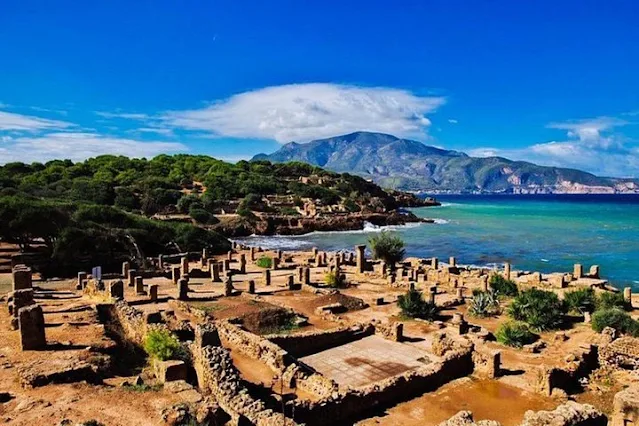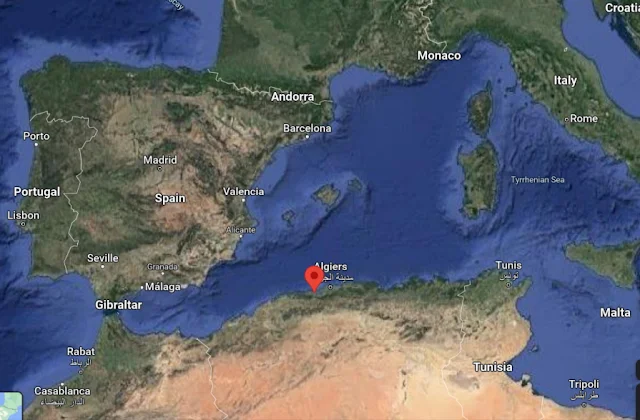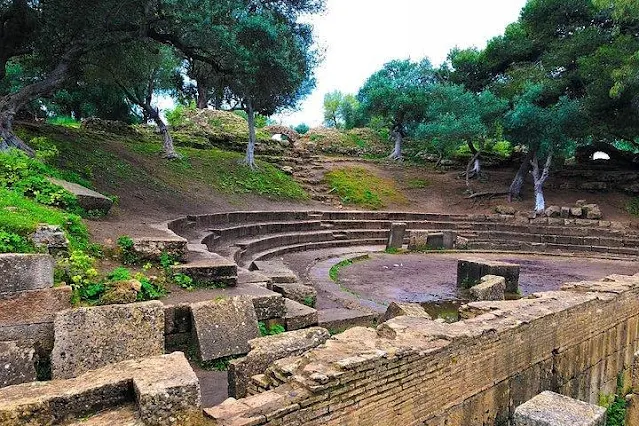Tipasa in Nuptials (Noces, 1939)
Albert Camus’s essay collection Nuptials (Noces), published in 1939, consists of four essays: Nuptials at Tipasa, The Wind at Djémila, Summer in Algiers, and The Desert. Among them, Nuptials at Tipasa (Noces à Tipasa) is the most well-known.
Here, “nuptials” does not refer to marriage between a man and a woman, but rather to a sensual union between human existence and nature, between life and the world. Tipasa is depicted as the sacred space where this union is realized—a literal wedding ground and sanctuary of being and nature.
Nuptials at Tipasa – The Unity of Nature and Being
In his youth, Camus visited Tipasa, a coastal city on the Mediterranean Sea in Algeria. There, amidst the sunlight, stones, sea, Roman ruins, and the scent of wild herbs, he experienced a profound sense of fulfillment—not through reason or divine revelation, but through the body and the senses alone.
“Here, I was overcome with the certainty that the world is beautiful, and that I was part of that world.”
— Nuptials at Tipasa, from Noces
For Camus, Tipasa was a place that awakened the essence of life—one that could embrace pain and death—and demonstrated that even in a godless world, life could still be sacred and full.
Ruins, Sunlight, and Affirmation in the Face of Absurdity
While gazing upon the ruins, Camus recognized the beauty of the living present through the remnants of a dead past. His concept of the absurd—the tension between human longing for meaning and the indifferent silence of the world—transforms in Tipasa. Here, absurdity does not call for rebellion but for acceptance. Even within meaninglessness, he finds joy in simply being alive and celebrates that sensation.
Geographical Note
Tipasa is the largest city in Algeria’s Tipasa Province, located at the northernmost edge of the African continent, stretching along the southern coast of the Mediterranean Sea.
During the Roman Empire, it was known as Tipasa. Around 1857, the modern city began to take shape. The site is notable for its impressive ruins of ancient Roman architecture and its sandy Mediterranean coastline.
In the late Roman Empire, Tipasa was an important center of Christianity, home to three large churches built in the basilica architectural style.
 |
| Basilica of St. Crispinus |
Saint Crispinus (also known as Crispinus or Crispino) and Saint Crispinianus were noble brothers from Rome. Around the year 285 AD, they embarked on a missionary journey to the region of Gaul (modern-day France) along with Saint Quintinus, eventually settling in Soissons. During the day, they devoted themselves to preaching the Gospel, and at night, they worked diligently as cobblers.
At the command of Emperor Maximian, who was visiting the region at the time, the brothers were brought before Rictiovarus, a known persecutor of Christians. Rictiovarus tortured them and repeatedly attempted to execute them, but when he failed, he ordered them to take their own lives. When they refused, Emperor Maximian ultimately had them beheaded.
They are venerated today as the patron saints of shoemakers.
(Source: Catholic Archdiocese of Seoul ⓒ GoodNews)


Theses images show the central urban area of the ancient Roman ruins in Tipasa, Algeria. Facing the sea, the site features remnants of basilicas, houses, public baths, and roads. It has been designated a UNESCO World Heritage Site. In the background, the Mediterranean Sea and part of the Atlas Mountains—specifically the Tell Atlas range—can be seen.
The term basilica (basilique in French) in ancient Rome referred not only to religious buildings but also to multi-purpose public structures where assemblies, legal proceedings, and other civic activities took place. Later, the architectural form of the basilica was adopted for Christian church buildings.
The Royal Mausoleum of Mauritania is an ancient circular funerary monument located near Tipasa, Algeria, believed to have been built around the 1st century BCE for King Juba II and Queen Cleopatra Selene—the daughter of Cleopatra VII and Mark Antony. The term “Mauritania” in this context refers not to the modern country of Mauritania, but to the ancient Berber kingdom of Mauretania, which occupied parts of present-day northern Algeria and Morocco. The mausoleum is a remarkable fusion of Numidian, Roman, and Hellenistic architectural styles, symbolizing the cultural and political ties between North Africa and the Roman Empire.


 |
|
Before Roman conquest, the area served as a trading post for Western Phoenicians who had migrated from the land of Canaan during the early Iron Age. Between 41 and 54 CE, Emperor Claudius of the Roman Empire established a military base there to conquer the Kingdom of Mauretania, which at the time spanned from present-day western Algeria to the Atlantic coast. By the 4th century, the settlement is believed to have had a population of around 20,000.









Around 430 AD, Tipasa was destroyed by the Germanic Vandals, who had established power across the Iberian Peninsula, North Africa, and parts of the Mediterranean. About a century later, it was rebuilt by the Byzantine Empire.
In the late 7th century, Tipasa was once again reduced to ruins following an attack by the Umayyad Caliphate. It remained abandoned until the 19th century, when it was revived as a modern town.
Algeria was a French colony from 1830 to 1962. During this period, the writer Albert Camus was born in 1913 in the town of Dréan—then called Mondovi. Tipasa lies roughly a six-hour drive west of Dréan.
 |
| A monument was erected in Tipaza to celebrate Camus. (Youcef Krache for The Washington Post) |
 |
| The monument reads: I understand here what is called glory, the right to love without measure.(Youcef Krache for The Washington Post) |
The monument bears the inscription: "Here, I come to understand what people call glory. It is the right to love without reservation."
This line is from Camus’s essay Nuptials at Tipasa.
Korean version: https://deposo.tistory.com/125




































Comments
Post a Comment